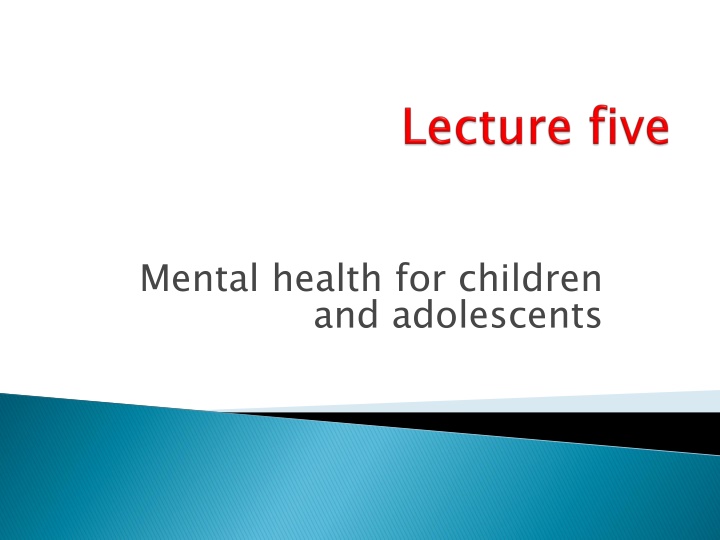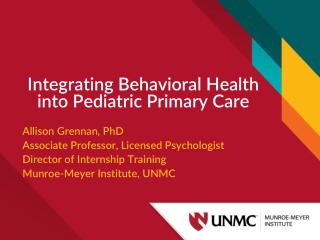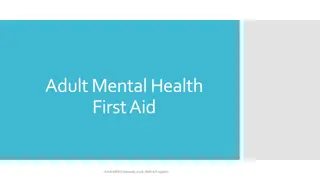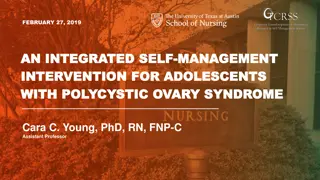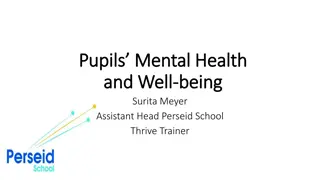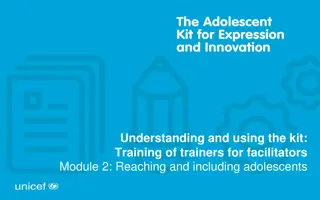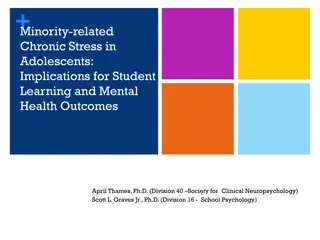Mental Health for Children and Adolescents
Mental health problems in children and adolescents encompass a range of emotional and behavioral disorders, including depression, anxiety, and eating disorders, with causes stemming from biological factors, environmental influences, or a combination of both. Factors such as exposure to toxins, violence, chronic stress, and significant losses can contribute to these issues, impacting various aspects of daily life and potentially leading to severe consequences. It is essential to prioritize the well-being of young individuals to foster their growth and development, as mental health plays a crucial role in their present and future success and overall quality of life.
Download Presentation

Please find below an Image/Link to download the presentation.
The content on the website is provided AS IS for your information and personal use only. It may not be sold, licensed, or shared on other websites without obtaining consent from the author.If you encounter any issues during the download, it is possible that the publisher has removed the file from their server.
You are allowed to download the files provided on this website for personal or commercial use, subject to the condition that they are used lawfully. All files are the property of their respective owners.
The content on the website is provided AS IS for your information and personal use only. It may not be sold, licensed, or shared on other websites without obtaining consent from the author.
E N D
Presentation Transcript
Mental health for children and adolescents
Introduction What are mental health problems The causes of mental health problems Environmental factors that cause mental health problems The impact of mental health problems Vocabulary Grammar: Sentence types
mental health can impact our daily life, as well as our future, in aspects such as schoolwork, relationships, and physical health. And like our physical health, mental is important at every stage of life. Caring for and protecting a child's mental health is a major part of helping that child grow to become the best he or she can be.
Mental health problems for children and adolescents refer to the range of all diagnosable emotional, behavioral, and mental disorders. They include depression, attention- deficit/hyperactivity disorder, and anxiety, conduct, and eating disorders.
Mental health problems can be caused by biology, environment, or a mix of both. Examples of biological causes are genetics, chemical imbalances in the body, and damage to the central nervous system, such as a head injury.
Environmental factors that cause mental health problems Exposure to environmental toxins, such as high levels of lead Exposure to violence, such as witnessing or being the victim of physical or sexual abuse. Stress related to chronic poverty, discrimination, or other serious hardships. Loss of important people in the lives of young people through death, divorce, or broken relationships.
Mental disorders can lead to school failure, family conflicts, drug abuse, violence, or suicide. Mental health problems often limit young people's current and future ability to be productive. In addition, these problems can be very costly to families, communities, and the health care system.
Mental: Stress: Impact: Suffer: Disorder: an illness Conflict: Disrupt: Disturbance: Impaired: made weaker or less effective Chronic: Mugging: the act of attacking someone and stealing their money relating to the mind or thinking great worry powerful effect to experience pain disagreement to prevent something from continuing something that makes someone worry continuing for a long time
A simple sentence contains a subject and verb; It expresses a single complete thought. A simple sentence is a single independent clause. Examples: The cat crept through the dark house. The mouse watched from underneath. The cat stopped and surveyed his surroundings.
A compound sentence contains two independent clauses joined together by coordinating conjunctions such as (for, and, nor, but, or, and yet, so). Examples: The cat was unsuccessful in his attempt to catch the mouse, and the mouse was equally as unlucky in his attempt to get the cheese. The dog had watched all of this, but he had refused to become involved. The mouse could wait until dark, or he could risk a daylight raid.
A complex sentence is an independent clause joined by one or more dependent clauses. A subordinating conjunction begins the dependent clauses. A dependent clause that begins a sentence must be followed by comma. A dependent clause has a subject and a verb, but it does not make sense on its own.
After he gave it some thought, the mouse decided to wait until later for his trick. The cat fell asleep on the warm kitchen because he was deprived of sleep the night before.
A compound-complex sentence is a sentence that has at least two independent clauses and at least one dependent clause. The same subordinating conjunctions are used to introduce the dependent clauses. The same coordinating conjunctions are used to join the independent clauses.
Kate doesnt like cartoons because they are loud, so she doesn t watch them. The dog started barking so the cat ran away and I couldn t keep up, so I stopped. Usually I take a walk every day while the sun sets, but it was raining today. She likes to sleep in but she can get up early if she has work.
